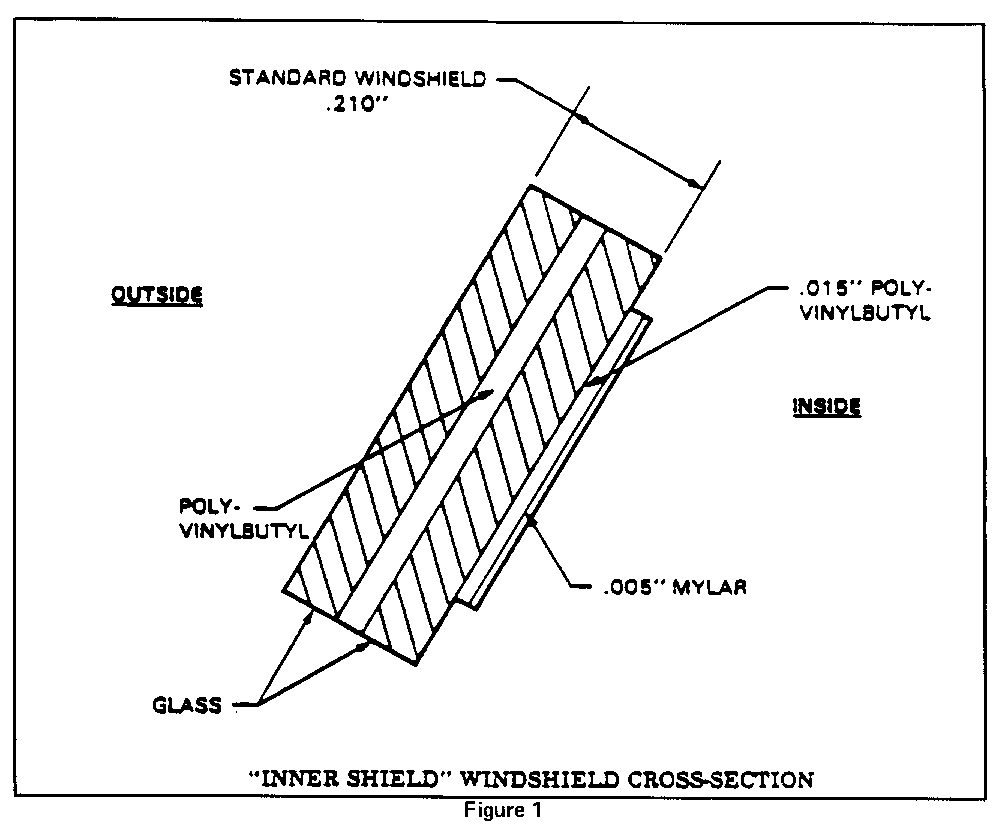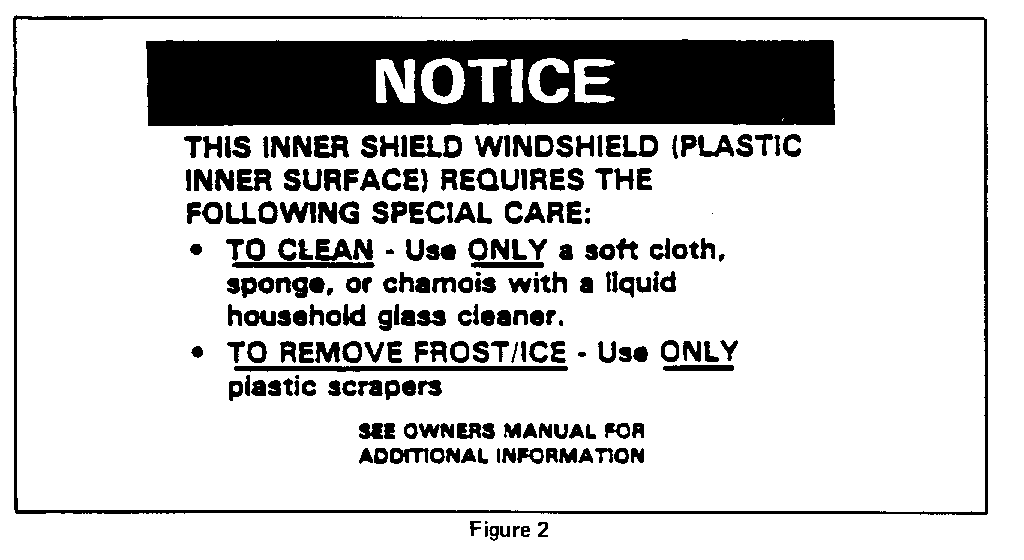ANTI-LACERATIVE WINDSHEILD IMPORTANT CLEANING PRECAUTIONS

"INNER SHIELD" WINDSHIELD
1986 TORONADO
All 1986 Toronado models contain an "Inner Shield" windshield manufactured by L.O.F. (Libby-Owens-Ford). This important new occupant protection feature was designed to reduce the risk of facial cuts from broken windshields in auto accidents. It also helps to keep glass splinters from entering the passenger compartment due to outside impacts. It features a thin two-part plastic composite layer applied to the inside surface of the windshield. See Figure 1. This windshield can be identified by the statement "Glass Plastic Material - See Owner's Manual For Care instructions" permanently laminated into the glass at the lower center on the inside.
A blue and white sticker attached to the right inside of the glass (Figure 2) contains cleaning instructions that the owner should be aware of. Do NOT remove this important sticker prior to delivery to the owner. The owner can easily remove the sticker by lifting one corner with a fingernail or credit card and slowly peeling the sticker off.
The thin two-part plastic composite layer can be damaged by improper cleaning or improper removal of frost or decals.
Cleaning
To clean the inside surface, use a soft cloth, sponge, or chamois moistened with a household liquid glass cleaner or water. Stubborn deposits may be removed using mineral spirits or isopropyl (rubbing) alcohol. When using alcohol, be sure to avoid sparks and flame and keep the doors and windows open for ventilation. Use mineral spirits and alcohol sparingly and avoid contact with other surfaces. Do NOT clean without one of the above liquids. Do NOT use abrasive cleaners or scouring agents such as scouring powder or steel wool.
Frost Removal
When removing frost from the inside surface of the windshield, use a soft cloth or plastic scraper. NEVER USE METAL BLADES OR SCRAPERS OR ANYTHING ELSE THAT MAY DAMAGE THIS PLASTIC SURFACE.
Decal Removal
Should anyone, such as a vehicle inspection station, be required to remove a decal from the inside surface of the "Inner Shield" windshield, be certain they are familiar with the proper decal removal procedure.
To remove a decal, use a fingernail or a plastic scraper (such as a credit card), to lift up one corner of the decal. If the decal has a plastic substrate, it should peel off in one piece if care is used. (Don't pull hard or tug at decal - slow steady pull pressure works best.) A decal with a paper substrate may tear and come off in several pieces. Soaking a paper decal with a water moistened sponge for several minutes, and then gently scraping with a plastic scraper, should aid removal. Any adhesive residue that is left can be cleaned with one of the cleaning agents previously mentioned.
Clear Primer Removal
Wipe off with an isopropyl alcohol soaked soft cloth. This works best if the primer is not allowed to dry on the surface.
Black Primer Removal
If primer is wet, wipe up with an isopropyl alcohol soaked soft cloth. If the primer is dry, it may be removed by gently scraping the surface with a plastic scraper.
Urethane Adhesive Removal
Urethane is easiest to remove if it is allowed to dry on the windshield surface.
Dried deposits can be removed by gently scraping the surface with a plastic scraper.
Should it be necessary to replace an "Inner Shield" windshield, it can be ordered through WDDGM under part number 20638766 and will be shipped directly from the supplier.
Please make certain that ALL members of the Dealership Sales and Service staff are familiar with the contents of this bulletin.


General Motors bulletins are intended for use by professional technicians, not a "do-it-yourselfer". They are written to inform those technicians of conditions that may occur on some vehicles, or to provide information that could assist in the proper service of a vehicle. Properly trained technicians have the equipment, tools, safety instructions and know-how to do a job properly and safely. If a condition is described, do not assume that the bulletin applies to your vehicle, or that your vehicle will have that condition. See a General Motors dealer servicing your brand of General Motors vehicle for information on whether your vehicle may benefit from the information.
